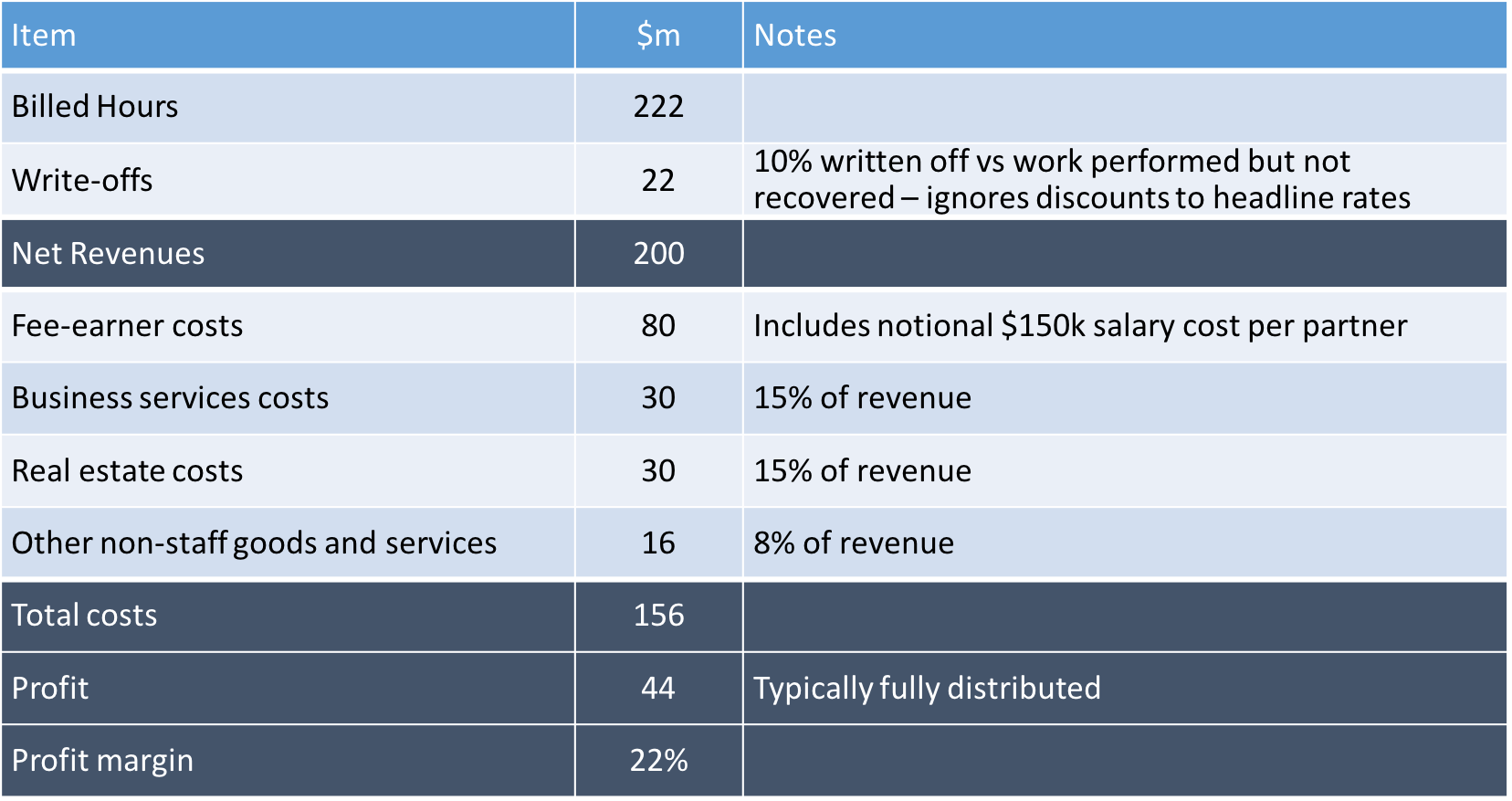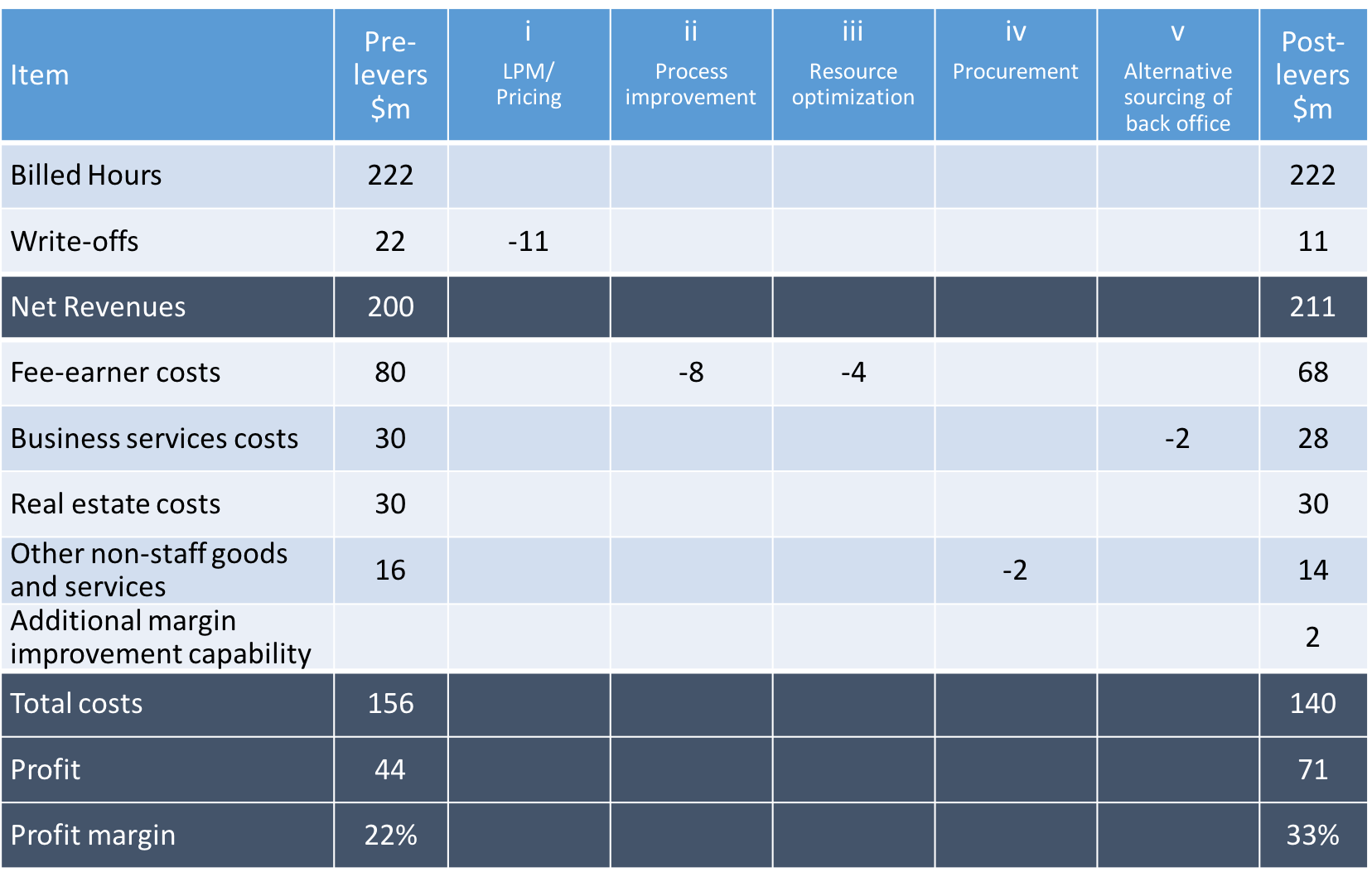Law Firm Margin Improvement: The Long Game
December 02, 2019
The Benefits Case
With geopolitical and economic uncertainty throughout the global economy, many larger law firms are regarding the outlook for 2017 and 2018 with a degree of trepidation. More sophisticated corporate buying behaviors and an uncertainty of transactional revenues are stalling revenue growth. The slash and burn of redundancy rounds may soon be upon us again. Yet, for all the lessons learned since 2008, it is surprising that margin management remains so tactical rather than an on-going strategic endeavor for law firms. The financial warning signs have been there for several years and clients’ expectations of consistency and efficiency of service delivery are clear.
We believe that the firms that will survive and thrive must invest in ongoing margin improvement capability. This will combine enhanced business and change management skills and will take a long-term view to drive out the more difficult changes that can come down to lawyer behavior.
To bring this to life, we model the impact of 5 big levers of margin improvement on the finances of an illustrative $200 million revenue law firm. The assumptions we use are all based on real margin improvements attained by major US, UK and other global law firms. They show how, collectively, these levers can increase profitability by over 52%. This is not fanciful economics – in our opinion, they are conservative numbers. Comparable professional services firms, such as strategy consulting houses, have achieved significantly more.
Our model firm
Our model is based on a $200 million firm, with 150 partners (salaried and equity), 400 other fee-earners (including paralegals) and 400 business services staff. Firms based in different geographies typically have different cost structures, such as higher charge-out rates in the US, for example. The cost structure we have modeled here is based on a UK firm, with figures in dollars for the benefit of our wider global readership. Key financials are as follows:

Please Note: for the analysis that follows, we have chosen not to focus on the costs of real estate, as many firms are tied in to long term leases, nor automation, which is a large and separate topic. Either would be largely additive to the savings modeled. We have assumed the outputs remain of the same quality, just that the production process has changed. Finally, we have not modeled any potential uplift in revenues from firms who advance these measures furthest, fastest.
The 5 levers
Spoiler: None of the levers that follow are silver bullets, nor novel in concept. However, they are areas where law firms typically have early-stage rather than mature implementation. As the change guru John Kotter says, “Don’t declare victory too soon.” These levers will have major contributory economic benefit if applied continuously and to their fullest extent. They are areas we believe should be central to a margin improvement focus. These levers are equally applicable to law firms in the US, UK, Australia, or other global locations, irrespective of the differences in cost base.
1. Legal Project Management (LPM) and Pricing
Many major law firms are now running Legal Project Management programs. Corporates, such as Barclays, have made it clear that this is a core competency they expect of their external counsel. Simplistically, LPM boils down to basic principles on how matters are managed. Up front, this requires careful scoping, budgeting and planning of matters and identifying key risks and issues to project delivery. This should underpin all pricing models. During the matter, it means managing to the plan, and updating progress against scope, budget, risk and issues as events unfold.
A key question is how much to invest and how to measure success against this. Investment is likely to come in the form of training, dedicated LPMs (increasingly chargeable to client work), pricing specialists and technology. The ROI we have seen targeted by one major firm is to reduce write-offs by 50% and is a target frequently achieved at a practice area level. With clearer communication to clients up front – better planning and clearer bill preparation aligned to the scope, this is an attainable goal.
Savings range attained:
Reduce write-offs by 50%
Key success factors:
- Either lawyer numbers to be reduced or capacity to be re-sold to realize the benefits
- Requires the right quality of LPMs to get traction and support from management to drive changes to lawyer behavior
- Partner engagement and buy-in is key
- Clear link between pricing and LPM disciplines
2. Legal Process Improvement
There tends to be a visceral reaction among lawyers to the idea that legal work can be process mapped. However, process consistency is highly valued by clients – when you start a new piece of litigation or an M&A transaction with a firm, irrespective of the partner, they want to know it is being done to a harmonized set of steps. Process mapping (or ‘matter planning’) helps eliminate cost and price variation among partners and represents opportunities to drive improvements. These improvements can come in the form of standardizing work outputs (key knowledge artefacts used along the way), re-allocating work to the most effective resource, or ‘unbundling’ work to new delivery models whether to lower cost offices, alternative providers or indeed automation.
Again, these concepts are not new among law firms, the key question becomes how fast and how far you can push the concepts. An initial benchmark that we’ve seen is for 35% of all work to be performed by more junior staff off a 30% lower cost base – whether to existing resources or new delivery models. Clearly, this represents challenges for the shape of firms which, in many cases, are misaligned to the work performed. There are also change management challenges in ensuring senior lawyers ‘let go’ of work manageable by more junior resources.
While there are obvious cost reduction benefits, the client facing benefits of faster and more predictable delivery are highly advantageous. Co-created process design with clients typically leads to stickier relationships.
Savings range attained:
35% of all legal work performed off a 30% lower cost base
Key success factors:
- Transparency of time-recording at a phase and task level
- Empowered LPM programs to ensure that new processes are being followed
- Change management and alignment of financial incentives to re-point senior lawyers at work most suited to their skill levels
3. Resource Optimization
Large firms serving major corporates will find the demand for different practices areas impacted by the vicissitudes of the economic cycle. Most large professional services firms (e.g. the Big 4) have, for many years, had a variable cost base using associate consultants to manage demand peaks. Several UK law firms have set up contract lawyer arms. However, with one or two exceptions, few are using it to manage internal resource availability as part of a resource optimization program. Rather, they are using them to develop new revenue streams or meet secondee requests. More systematic use of contract lawyers internally drives more cost-effective resourcing models.
Savings range attained:
Reduce permanent legal staffing by 5% to increase utilization, replacing fulfilment of peak demand with contract lawyers
Key success factors:
- Developing central resource allocation capability
- Alignment of partner rewards to practice area utilization rates
4. Procurement of non-staff services and goods
All firms broadly buy the same things – whether it is stationery, telecommunications or catering, and yet they pay very different rates for them in the market. Why is this? Firstly, because many law firms do not have a deep understanding of their demand to be able negotiate effectively. Secondly, because most suppliers will make it difficult to see the real rates of these goods and services by selling them in bundles or in retainer agreements. Strip down the equation to a simple price vs quantity discussion and there are significant savings to be had through negotiation to market prices if demand is well understood. Many law firms have either a sub-scale or no dedicated procurement function as the spend does not justify the permanent investment. There is significant benefit in the use of third party benchmarking, consumption analytics and negotiation, to drive best commercial pricing leaving supplier relationship management as an internally sourced capability.
Savings range attained:
15–20% of non-staff goods and services
Key success factors:
- Ability to understand unit price and quantity of underlying deals
- Understanding of both market pricing and internal consumption
- Objective commercial negotiation
5. Alternative sourcing of business support functions
Now a reasonably well trodden path, many major firms have looked to move commoditized business support services to lower cost locations. The more ambitious firms have moved up to 25% of headcount to nearshore or offshore offices, either in captive models or outsourced. However, this falls short of other professional services – many consulting firms and banks for example have moved up to 80% of their finance functions to lower cost services, and in outsourcing arrangements (more typically) use SLAs to drive down the cost of delivery over time.
Savings range attained:
15–20%
Key success factors:
- Process standardization a prerequisite for successful implementation
- Management buy-in to deliver difficult change
- Fee-earner change management efforts to land successfully
Implementation and run rate costs
Each margin improvement lever will have associated implementation costs. These will vary but each should deliver an ROI within 2–3 years. For our business case, we have included an additional 10–12 FTE equivalent of relatively senior change resources to drive the multi-year program. This assumes certain levels of existing capability, but is typical of the incremental internal investment required to enhance effective execution. Typically, these would be supplemented by external resources to manage specific and larger elements of this change at peak times (e.g. setting up low cost offices). These external costs have not been included in this model.
5 levers impact
So, what is the impact on our illustrative firm?

In total, an increase of 52% in the overall profitability of the firm as well as an increase in revenues, without changing the service levels. Of course, this is not a short-term endeavor but rather a multi-year program of change. These sorts of results might be expected within a 3–5 year timeframe.
Making it happen
Accepting that many firms have been or are looking at these levers, the reality is that relatively few have been able to make material progress in delivering meaningful margin improvements. The reasons vary but there are several common themes and some approaches that can be employed to improve the chances of success.
Capacity for additional investment
Inevitably there must be some incremental investment to mobilize and drive a material improvement in operating margin. As the need to drive these more difficult changes is often only crystalized by a tightening of budgets and falling PPP, additional investment is often the last thing available. So, it critical that the initial steps taken are focused on some quick (in budget year) cost reductions and freeing up of resource to create the capacity for investing into longer term improvement. Two options available are:
1) Focused push on rationalizing procurement costs (lever 4, above) due to negligible change management required and rapid benefits realization
2) Review and rationalize current improvement activity. Built into every (business services) budget is some capacity to change and improve the way work is done. Often this can run to a surprisingly large figure but unless called out explicitly it rarely translates into real improvements in service or efficiency. Exposing this element of the budget and taking a cold, hard look at whether it is achievable, necessary or the best use of funds can free up significant capacity. Key questions to ask include:
- What is the benefit, how will it be measured and how is accountable for its delivery? And then stopping dead at least a proportion of those initiatives with no clear, measurable benefit, or those that are not directly aligned to client service or cost reduction.
- What happens if we do nothing? A simple question but in many cases the impact is low. Yes, there is the risk of building up some institutional debt if much needed improvements are further delayed but in the current environment, starting the journey towards material margin improvement may be much more urgent.
- Does the organization have the capacity to deliver or digest the budgeted changes? In many cases the budget may be available but the internal resource or management time may not be. Taking an aggregate view across all material change projects usually highlights that it would be impossible to deliver them all. Some tough prioritization decisions may be required but allocating budget to projects where there simply isn’t the resource to deliver is wishful thinking and a waste of time and money.
Typically, there isn’t the resource or a sufficiently objective perspective available internally to conduct this sort of exercise without some external support, and so some external investment is required. However, the payback period is short and over a period of weeks it’s possible to identify savings in allocated budget and resourcing that can provide the capacity to initiate a more strategic change program and have an immediate impact on in-year P&L.
Building the right team
Visible and vocal sponsorship from the Management team is obviously key. Of equal importance, though is the day-to-day leadership and personal commitment provided by a (senior) Partner who is willing to sponsor and lead the program. Someone with a long history with the firm, an agitator for change with the management experience, energy and commitment to the long-term future of the firm but who is willing to drive some of these difficult changes.
Leading, shaping and delivering this sort of multi-faceted, multi-year strategic change is very difficult. It’s vital to the buy-in, ownership and cost effectiveness of the change process that internal resource are very quickly involved as much as possible.
Across any firm there are usually several top performers at all levels and rising stars that are catalysts and agitators for change in their functions. The sort of people that can get things done with minimum fuss. They understand the local environment, have relationships across the organization and possess a blend of project and change management skills necessary to succeed. These are the people to bring together into a semi-permanent project team to shape and deliver the changes. Key skills required will be experience of managing strategic programs, behavioral change expertise, process improvement experience and communications. Most of the team will have experience of applying these skills in a law firm environment but they will need to be augmented with external hires who bring expertise and new ideas, underpinned by emotional intelligence and the resilience necessary to see longer term change through.
Staying on track
As we’ve said, the short-term cost-cutting elements of margin improvement have in many cases been exhausted. There is always some more that can be done but the sustainable changes in margin improvement are going to rely on much more difficult cultural and behavioral changes that cannot be forced on a law firm environment. Building a ‘big bang’ approach to such sensitive changes is likely to mean that as much effort is investing in gaining buy-in as in delivering the improvements. This is maybe inevitable to a certain extent but a longer-term view, supported by an embedded team, should enable incremental change to be delivered much more sustainably and efficiently.
Setting challenging (but achievable) targets is critical. Margin improvement and performance targets at a top level are the real goal rather than the delivery of any particular initiative. A continued focus on these, however uncomfortable, is key to avoiding the easy trap of delivering the project but not achieving the real business goals. Some methods we’ve seen include:
- Revenue and recovery targets for practice groups
- Cost reduction targets for business services alongside service level agreements
- Zero base budgeting. No rolling over of budgets year-on-year but a bottom up approach that forces review of what is necessary to maintain a service and what could be invested to improve it
- HR linked incentives, e.g. performance improvement directly linked to measurements of profitability and continuous improvement
Any multi-year, margin improvement program must fight for resource across the firm to ensure sustained delivery. Many smaller margin improvement pilots will be overshadowed by larger technology or office investments and often rely on the same few business services resources to deliver. Building a view across all the change in an organization and being able to prioritize across all the moving pieces is complicated, but key to sustaining ongoing focus on a program of change. This is a view created by the ‘change rationalization’ exercise and maintaining it and using it as a base for prioritization is a tool for keeping the portfolio of change activity balanced and effort focused on the real priorities.
One potential outcome is that the change program becomes a permanent endeavor that is never finished. On one level this is the worst-case scenario that is feared when the program is set up, but done well the change program subsumes current change activity and provides a more coordinated, efficient and effective way of managing change across the business. Constant change is slowly becoming less of an anathema for law firms but in the emerging future of law those who are unable to continue to change and react to client needs and emerging competitors will not survive. Change is not easy and the legal market is still learning how to do it well. Those who learn fastest will win. As a corporate client of ours recently coined things, “we’re realizing that changing the business is the business.”
This piece originally appeared on Law360.com in slightly modified format.
Back to Expertise

